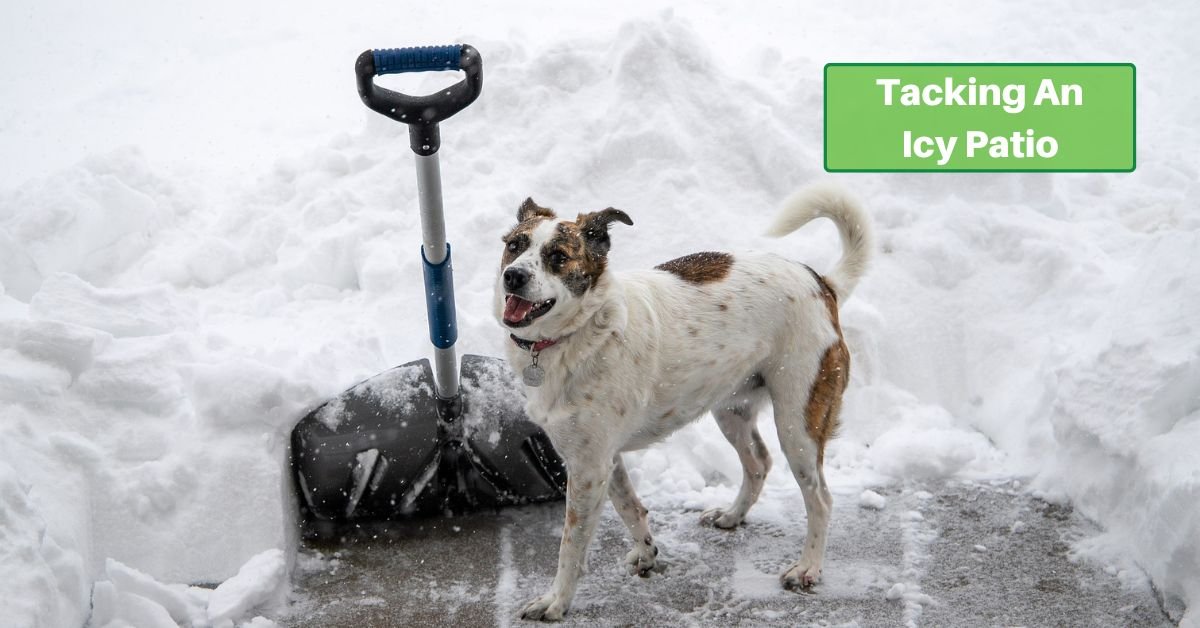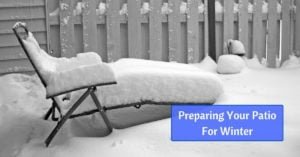No matter how much we dream of a white Christmas, we hate dealing with the ice and snow of winter. Removing it from walkways and other outdoor surfaces like patios is challenging. A frosty patio might present a picturesque scene. Still, it brings a host of challenges that homeowners need to address. The formation of ice on your patio is not just a minor inconvenience; it’s a safety hazard and a potential threat to the integrity of your outdoor living space.
Understanding and effectively dealing with ice accumulation is crucial for maintaining the safety and longevity of your patio. This guide offers some strategies for tackling this challenge so your patio remains functional and safe during the colder months.
Understanding the Risks of Ice
The primary concern with ice accumulation on patios is the risk of slipping and falling. Falls account for many winter-related injuries yearly, and an icy patio can significantly increase this risk. It’s not just about the physical injuries; a fall can also lead to lawsuits if guests are injured on your property. So, if you want to use your patio space even after nasty weather, you need to clear it of slippery hazards properly!
Beyond the immediate dangers to people, ice can also damage the patio itself. Most patio materials, including concrete, brick, and stone, are susceptible to the freeze-thaw cycle. This cycle occurs when water seeps into cracks or pores in the patio material, freezes, and then expands, causing the material to crack or break apart. Over time, this can cause significant damage, requiring costly repairs or even complete replacement of the patio.
Preventive Measures
The best strategy to deal with ice on your patio is to prevent it from forming in the first place. You can implement various preventive measures to minimize ice accumulation.
Ensuring that your patio has proper drainage is crucial. Water that pools on the surface will freeze into ice patches as temperatures drop. Creating a slight slope on your patio encourages water to drain away from the surface. Keeping gutters and downspouts clear can also prevent water from spilling onto the patio.
Choosing weather-resistant materials can make a big difference when constructing or renovating a patio. Some materials are less porous and more resistant to the freeze-thaw cycle. For example, certain types of concrete and stone are treated to be more durable in cold weather conditions.
Keeping your patio clean can also significantly reduce the risk of ice formation. Leaves, debris, and dirt can trap moisture and contribute to ice buildup. Regular sweeping and cleaning, especially before the onset of winter, can help mitigate this issue.
Applying a sealant to your patio can provide an additional layer of protection. Sealants can prevent water from penetrating the surface, thus reducing the risk of freeze-thaw damage.
When the snow does fall, promptly removing it can prevent it from compacting and turning into ice. It’s easier to shovel fresh snow than to chip away at ice later. However, be cautious with the tools you use; metal shovels or tools can scratch or damage the patio surface.
For those in particularly icy climates, investing in heating solutions such as heated mats can effectively keep ice at bay. Put the pads in place before the snow or ice falls, and keep them turned on until everything melts. These pads may represent an upfront cost but can save a lot of labor and potential damage in the long run.
Through these preventive measures, homeowners can significantly reduce the likelihood of ice forming on their patios. However, despite the best efforts, some ice formation may still occur.
Safe Ice Removal Techniques
When ice does cover your patio, it’s crucial to remove it safely and effectively to prevent accidents and further damage to the patio surface. Here are the parts of the removal process:
The most immediate method of ice removal is shoveling. Be sure to use the right tool for the job. A plastic shovel is often recommended over metal as it’s less likely to scratch or damage the patio’s surface. Start shoveling as soon as possible after the ice forms to prevent it from bonding strongly with the patio surface.
When shoveling isn’t enough, you can consider ice melt products. There are several types, each with advantages and disadvantages. Rock salt (sodium chloride) is the most common and inexpensive option. Still, it can be harsh on plants and concrete and is ineffective below 20°F (-6°C). Calcium chloride is more effective at lower temperatures and less harmful to vegetation, but it can be more expensive. Follow the manufacturer’s instructions to avoid damage to your patio and the surrounding environment.
Sand and Kitty Litter don’t melt ice, but they offer traction on slippery surfaces. They are an excellent option for immediate, temporary safety, especially in areas where chemical deicers might cause damage.
Pouring hot water on the ice can melt it quickly, but use this method cautiously. The water can refreeze, potentially making the situation worse.
Natural and Eco-Friendly Alternatives
In response to environmental concerns and the potential damage caused by chemical deicers, many homeowners seek natural and eco-friendly alternatives for ice removal. Let’s consider a few options.
Many types of pet-friendly deicers are available that aren’t toxic and won’t irritate delicate paw pads.
A mixture of vinegar and water can be used as a de-icing agent. While less effective than commercial deicers, it is a safer alternative for your patio, pets, and plants.
Sugar beet juice, mixed with salt, can lower the freezing point of water. It’s less corrosive than traditional salt and is biodegradable.
Alfalfa meal is an effective natural ice-melting agent. While primarily used as a fertilizer, its natural stickiness provides good traction, and its nitrogen content helps to melt ice.
You can also spread used coffee grounds over the ice. They provide traction, much like kitty litter or sand. They also offer a slight warming effect; their dark color means they absorb more sunlight, much like you feel warmer when wearing a dark T-shirt under the sun.
Long-Term Solutions and Patio Care
Long-term strategies can significantly reduce the hassle of dealing with patio ice.
Installing a heated patio system is an effective, though expensive, solution. These systems melt snow and ice upon contact, ensuring your patio remains clear throughout the winter. These are also great options for driveways.
Also, consider redesigning your patio with ice management in mind. This includes optimizing drainage, selecting ice-resistant materials, and incorporating areas where you can pile snow and ice after removal.
The importance of regular maintenance – no matter your type of patio – cannot be underestimated. Regular sealing and repairing any cracks or damage in the patio can prevent water from seeping in and freezing. This proactive approach can save significant time and money in the long run.
Managing ice on your patio requires a combination of preventive measures, effective removal techniques, and long-term strategies. By understanding the risks and options available, you can ensure their patio remains safe and functional during winter. Whether you opt for traditional methods like shoveling and ice melt products or more natural alternatives like vinegar solutions and coffee grounds, the key is to be proactive and consistent in your approach. With the proper care and attention, you can maintain the beauty and integrity of your patio, making it a year-round asset to your home.









